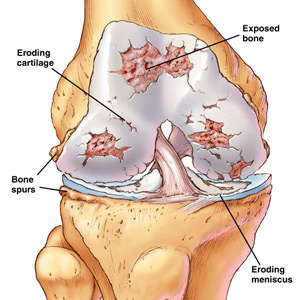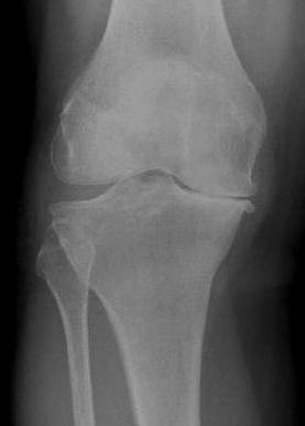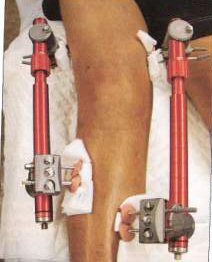- Home
- Knee arthritis
- Knee joint distraction
Knee joint distraction
Knee Joint Distraction is proving very successful in the Netherlands in treating the younger patient with advanced osteoarthritis of the knee.
Typically, a total knee replacement lasts only about 15 years, says orthopaedic surgeon Dr Lafeber of the University Medical Centre, Utrecht. So an orthotic at 60 will typically need to be repeated at 75 which is complicated and expensive, and the results are often disappointing, according to him.

Hypothesis
Dr Lafeber's rationale for his Knee Joint Distraction technique for advanced osteoarthritis in the younger patient is that osteoarthritic cartilage is capable of self-repair if the joint is
unloaded and chondrocyte nutrition is maintained.Biomarkers of cartilage turnover were measured for twelve months. During the distraction phase there was enormous turnover of cartilage, with increased synthesis AND breakdown of cartilage.After the distraction phase was complete, there was gradual decrease of breakdown, but cartilage increase continued.
Symptoms
Typically, patients with advanced arthritis in the knee rate their pain and disability scores very high. However, for patients younger than sixty this creates a great dilemma. Surgery before sixty is definitely to be avoided if at all possible, but obviously the younger disabled patient is likely to grasp at fifteen better years, and worry about 70 if and when it arrives.
Currently, over 1000 total knee replacements are done in the Netherlands for patients under the age of 60. Rather consider KNEE JOINT DISTRACTION ...

Technique
Pins are drilled through the bone just above and below the knee, and then a spring loaded distraction frame is fitted, unloading the knee by increasing the distance between the cartilaginous surfaces of the knee by 5mm. The external frame remains in place for two months allowing the patient to walk and bend the knee, but with the knee joint unloaded.
Synovial flow is vital for cartilage nutrition.
The fluid pressure within the joint is repeatedly increased and normalised by the springs, resulting in a continous flow of synovial fluid through the joint, absolutely vital for healthy chondrocyte nutrition.
Periarticular bone turnover results in the release of multiple growth factors, stimulating chondrocyte repair.
There is much research confirming the similar effect in the spine. Immobilisation of any joint, for any reason, cause the rapid onset of cartilage degradation.
Read more about Immobilisation Arthritis.

Results
"Within six months we see a significant decrease in pain and significant improvement in functional ability," says Dr. Lafeber. "Patients start at 80% of the maximum pain score, which is severe pain, and it decreases to about 20 percent, and continues to decrease to 8 at the two year followup.
Functional ability improves to 80 to 90 percent within a short period after the two month distraction period is complete. Patients continue to improve after the frame is removed until they have almost complete normalization of the joint."
MRI studies confirm the findings.
MRI studies done one year later (and read by a blinded radiologist) confirm that:
- Subchondral bone coverage increased by 40%
- Cartilage volume increased by 50%
- Cartilage thickness increased by 25%.
Radiologically this translated into a dramatic 40% increase in joint space within the knee.
Some of the patients have been followed for four years with "durable retention of the initial benefits".
Ankle arthritis
Similar results have been achieved within the ankle, with continuing improvement for ten years being confirmed. 73 patients undergoing three months of ankle distraction experienced dramatic improvement in ankle joint pain and foot pain and disability ratings.
Limitations of the study
Whilst the results of ankle and knee joint distraction seem impressive, researchers acknowledge there were no controls, nor was the study placebo controlled. Further studies are needed to confirm the results.
Knee exercise
So often we tend to look at research, and choose to ignore it. Research proves that smoking knocks ten years off one's life. That is rubbish, I do not believe it. High cholesterol critically raises the risk of stroke and heart attack. Maybe so, but I like my food. Why should I be miserable?
Prevention, that is the buzz word. Powerful research confirms that you can prevent arthritis in your knees by doing more exercise. And that probably applies to all joints.
Read more … KNEE ARTHRITIS and EXERCISE ...Chiropractic adjustments
"This procedure creates separation in the knee and thus reduces pain and restores functional ability in people who have severe osteoarthritis."
- The researchers
Chiropractic adjustments of the spine parallel Dr Lafeber theories concerning ankle and knee joint distraction. It is known that spinal manipulation causes joint distraction (unloading) with sudden drop of intra-joint pressure, causing small bubbles of nitrogen to come out of solution, thus increasing the flow of fluids through the joint (chondrocyte nutrition).
Lafeber's research also confirms many other studies concerning Immobilisation arthritis, in which precisely the opposite occurs. Immobilisation of any joint, whether due to joint fixation or injury, or external fixation, say with a cast, thus preventing the continuous flow of synovial fluid through the joint, rapidly leads to cartilage destruction.
KNEE JOINT DISTRACTION is part of the solution.
Anecdote
A young patient of mine was shot in the upper thigh, fracturing the femur. There was no injury to the knee, but because of complications his leg was braced for over a year, preventing him from flexing the knee. He never regained the use of the knee, which remains completely rigid.
Self-manipulation
Chiropractors are faced on a regular basis by patients who manipulate their own spinal joints several times a day. Whilst short term relief of pain apparently is achieved, long term the condition rapidly deteriorates with ultimate increased osteoarthritis and nerve injury.
What is not well understood is whether this is because of too much manipulation, or improperly applied manipulation, or both. Certainly a self-manipulator is unable to apply the distraction which is key to the chiropractic adjustment. Without first unloading the joint, I personally suspect that self-manipulation increases the trauma to, and degeneration of, the joint cartilage.
Whilst occasional manipulation certainly increases spinal health, and prevents immobilisation arthritis, how much manipulation is appropriate remains unresolved.
My own opinion is that 25 manipulations of a specific joint within a period of one year, is too much manipulation, perhaps far too much. But that is simply an unresearched opinion.
Conclusion
Joint unloading and increased nutrient flow using knee joint distraction reverses both the pain and functional limitation of the cartilage in end-stage osteoarthritis of the knee. It applies also to the ankle, and presumably to all joints.
Obesity
Obesity is the major cause of knee arthritis. Extended increased pressure on the hyaline cartilage in the knee inhibits the chondrocytes - the cells that build new cartilage. Pain. The time to start with our Free Weight Loss Programs is not when you have serious pain and disability, long before you have to start considering KNEE JOINT DISTRACTION. Now!
ARTHROSCOPY KNEE SURGERY
Whilst I'm astonished what a good surgeon can often achieve, their own research suggests that for many conditions in the knee, arthrosocpy knee surgery is less effective than a sham (placebo) treatment.
Clarkes test is the gold standard for Patello Femoral Pain syndrome, arthritis under the knee cap.
Always think Chiropractic before surgery, whether it's your knee, back, neck or hip. Unless your leg is in ten pieces after a car accident!
Osteoarthritis links
- Taking more than one anti-inflammatory simultaneously: DUAL ANTIINFLAMMATORY DRUGS ...
- Chicken bones bouillon for Osteoarthritis. Make it at home...
- Fish oil for osteoarthritis
- Oleocanthal in Olive oil benefits for arthritis
Knee joint distraction
Knee joint distraction research reveals dramatic increase in cartilage volume, thickness and bone covering.
- Home
- Knee arthritis
- Knee joint distraction
Did you find this page useful? Then perhaps forward it to a suffering friend. Better still, Tweet or Face Book it.
